By Bob Shell
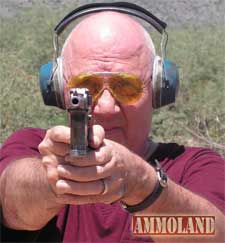
Apache Junction, AZ –-(Ammoland.com)- When reloading rifle ammo there are some important tolerances to keep in mind if you want the best possible ammo and there are certain tools that help you keep those tolerances correct.
That is especially true if you are involved in competition shooting. When the difference is .002 between first and 10’th place in a match each little measurement is critical.
Note: For this report, Brownells.com supplied all of the measuring equipment. If you are looking for a company that sells all types of tools and many other things Brownells will have it.
They also carry ammo and reloading components among many other items too numerous to list here. For info you can go to https://www.brownells.com/ The Brownell company is devoted to serving the customer and one way they do that is they have a phone line set up so if you have a question a call to one of the knowledgeable staff will help you resolve it. It is a free service and has helped out many shooters. They can be reached at 800-741-0015.
Lets look at some of the tools used in precision reloading.
One of the important measurements is the case length. For the purposes of this report, we are using some 308 semi auto rifles as examples. Most semi-auto rifles demand that the length is precise. If they are too long even by a few thousands of an inch, chambering may be difficult or even impossible. Other problems caused by long cases is inconsistent ammo and in some instances can cause high pressure. That is caused by the excess brass going into the rifling causing a constriction problem. The case can’t release the bullet properly causing that problem. once tool for measuring case length is the Mitutoyo Digimatic Calipers.
Mitutoyo Digimatic Calipers:

The Mitutoyo Digimatic Calipers are ready to measure right out of the box, no programming. You open jaws with the smooth-feel thumb wheel and read the LCD display. No reading “between the lines!” If you want to compare dimensions, reset the zero anywhere on the scale, caliper will give plus/minus readings. Close and reset zero and it’s a regular caliper again. Graduations also marked on the beam for a quick manual check. No rack and pinion to get dirty, no delicate glass scale. 6″ model bears the brunt of your measuring around the home and shop. 8″ version cover those bigger specialized projects like measuring .50 BMG cartridges.
A digital vernier is one way to measure the cases. Brownells sells a Mitutoyo Digimatic Calipers online. and it can measure in inches or millimeters. There is detailed instructions in several languages and provided good service during the test. A vernier is necessary in any shop as they are used for many jobs including measuring case length. It is also used for measuring loaded length. I can’t imagine a reloading setup without one. Once you establish that info, you can note it for future use. Keep in mind that different bullets of the same weight may require different seating depths because of the shape of the bullet.
Hornady Overall Length Gage
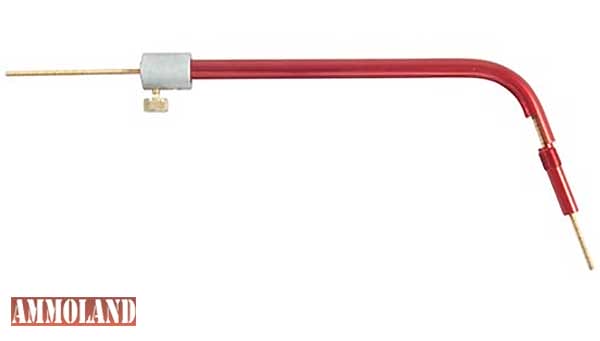
Hornady makes a case OAL length gauge. From their description:
“The Hornady Lock-N-Load OAL Gauge (formerly Stoney Point) is an extremely easy to use tool. It only takes a couple of minutes to find the overall length for a particular bullet. The tool is threaded on one end to accept specially modified cartridge cases. Once threaded onto the tool, a bullet is inserted into the cartridge. The tool is then inserted into the chamber of your rifle. The push rod on the tool is used to push the bullet up against the rifling. The rod is then locked in place and the tool can be removed from the rifle. You then measure across the base of the cartridge and the top of the bullet with your dial calipers (use of a bullet comparator at this time is highly recommended) to obtain the OAL. If you want to check another type of bullet, insert the new bullet into the tool and repeat steps.”
“There are two different models of OAL Gauge tools available. Straight is designed specifically for bolt-action rifles and single shot rifles. The Curved model is designed for autoloaders and lever actions. Both models utilize the same modified cases. Either tool will work on the AR-15 type rifles. These tools will not work on Winchester Model 94’s. This tool is excellent for periodically checking the throat erosion of a rifle barrel. Great for checking out used rifles. There are over 60 different modified cases available to use with this tool.”
You have a case that has a threaded primer pocket with a long rod that screws in. The case 308 in this test has a neck that allows the bullet to be seated tight enough to hold it but allows some movement. The purpose is to be able to adjust the bullet seating at the length you want it. The main purpose is to seat the bullet as close as possible to the rifling without touching it. For those who are interested in super accuracy this is part of the formula in achieving that goal. For hunting ammo, you might not want it quite as close because you may have a round that is a tiny bit too long. What may happen is when you extract the ammo a bullet too far out can stick into the rifling. Out in the field that can be a disaster. If you are chamber checking your ammo, and you should be, and notice a very light ring at the front of the ogive that may be an indication that they are too long. With hunting ammo reliability is everything. For more info on Hornady’s extensive line go to www.hornady.com .
LE Wilson Case Gauge
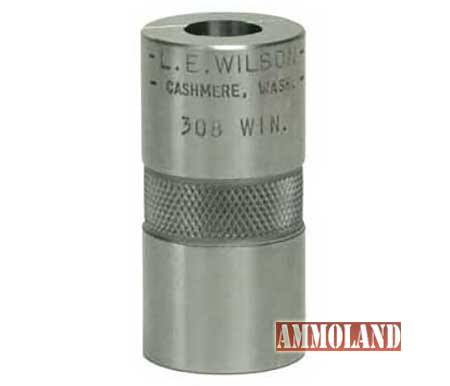
The most important use of a cartridge case gage is for setting up 7⁄8″-14 press type full length resizing dies. A common error in reloading is to oversize your brass. Headspace of fired cases can quickly and accurately be measured using this tool and a caliper.
Since we are using at least three different rifles LE Wilson Case Gauge comes in very handy. You can use it for checking length or get an idea on the headspace of an individual rifle. The Wilson case length gauge was an important part of this project.
Sinclair Concentricity Gauge
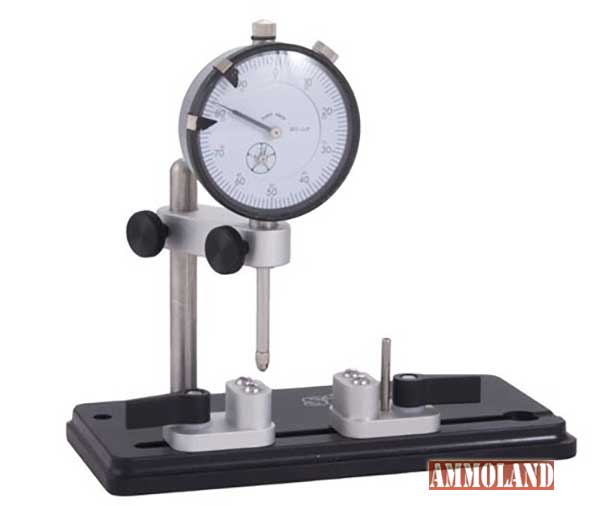
Another tool used is a dial indicator tower used to measure the depth of something. It can attach to a Sinclair Concentricity Gauge.
Brownells believes the Sinclair Concentricity Gauge is the easiest to use and most accurate gauge of its kind on the market. Precision made for a lifetime of use, the Sinclair Concentricity Gauge will accept cases up to 50 BMG.
The Sinclair Concentricity Gauge is used to measure runout by rotating the case or loaded round on two sets of bearings that are captured in anodized aluminum blocks. These bearing blocks are adjustable longitudinally to allow for different case lengths or varying lengths of loaded rounds. The handloader can measure sized cases on the neck, and measure loaded rounds on the neck or out on the bullet. The bearing blocks ride in a milled slot in the gauge base plate. This milled slot keeps the blocks in alignment with each other.
This arrangement provides the best support for the cartridge, enabling the user to spin the cartridge smoothly. Large thumb levers on the bearing blocks make adjustments quick and easy. The anodized base plate is extremely stable allowing the user to take accurate readings. The indicator tower is designed to permit vertical and side-to-side adjustment of the dial indicator. The mounting block for the dial indicator is designed to accommodate dial indicators with standard 0.375″ mounts. This is a quality measuring tool for the serious precision reloader.
The purpose is to insure that the case is as round as possible. Out of round cases and bullets can cause accuracy problems especially in competition guns. Sinclair makes a lot of precision tools to help reloaders get the most accuracy possible out of their guns.
Sinclair Bump Gauge
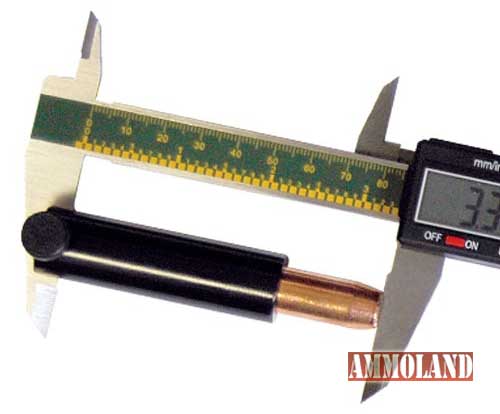
Another tool that competition shooters find useful is the Sinclair Bump Gauge. It measures the headspace. The best ammo will have a measurement that is .001 shorter then the chamber. The less a case stretches the longer it will last and it will be more accurate. This gauge will help you set up your sizing operation to match the gun at hand. There is a very large verity of specialized tools available for the target shooters made by Sinclair. For info you can go to www.sinclairintl.com
Most of these and similar tools are for competition shooters or those who may want to extend their brass life some. The closer a round is to the chamber the more accurate it can be. When you are doing precision work such as competition or sniper work every little dimension is important. In order to get the best results each round should be exactly or as close as possible to the other rounds. The difference between precise ammo and typical may be only be ½” at 100 yards but that may be the difference between 1’st and 40’th place in a match. With a typical rifle with looser tolerances, match ammo won’t help out much. Then of course is the shooter’s ability.
The Test
As part of our example test we have three military semi auto rifles and wanted to see how the ammo performed as to reliability and used three different powders to check velocities. We used the same amount of H-4895, 4064, and the new 4166 and the 150 grain Privi FMJ in all of the guns. The Rock River shows some pressure signs with the 4166. There are shiny ejector marks on the case heads indicating that we need to back off a grain. The M1-A doesn’t show such signs. Putting them in the Wilson case gauge shows that the hot loads stretched more than a load using 4895 which shows how handy the gauge can be when developing loads. Neither other powder shows pressure signs. The load for all three powders is 42.5 grains.
- Rifle LAR-8 Rock River with 4166 2752.4 consistent
- Rifle M1-A Springfield with 4166 2717.89 also consistent
- Both rifles showed that it is a max load and should not be exceeded
- Rifle Rock River LAR-8 with H-4895 2724.3 real nice
- Rifle M1-A Springfield with H-4895 2726.8 consistent – Both rifles liked that load
- Rifle M1-A Springfield with 4064 2607.8 fair
- Rifle DS Arms with 4064 2567.56 fair
IMR 4064 did not do as well as 4895 as the velocity is lower and the standard deviation is higher. Probably adding a grain of powder would improve that. In other rifles it may do better. It shows that each rifle is an individual and to get the best out of it the work has to be done with that rifle. With all three rifles there was no jams or any other issues in regards to feeding or chambering. A RCBS small base sizing die was used something I would recommend when loading semi rifles.
During this test, I had another goal. IMR Powders has come out with three new powders and I used one for this project and compared them to a couple of well-known propellants used in the 308. I was looking for a load that gives similar ballistics to the military 308 load. This powder fills the bill and is definitely a viable propellant for the 308 military rifles as well as many other calibers I am working with. I will be publishing a lot of data later.
When you reload ammo for any gun the first question is why are you making your own? There are a verity of reasons people get into handloading. If you have a basic hunting rifle and are a hunter and occasional shooter then you don’t need a lot of high price equipment as it won’t help you. That is true with bullets. Most of the time a basic cup and core bullet will do everything that you anticipate doing. If you buy the basic equipment of good quality that is all you need. Most big game is taken within 200 yards and a good basic setup will suffice. For most calibers there is a vast selection of bullets and some thought should be used when selecting a projectile. Since that is the payload using the correct one will produce the desired results. So if you have a match grade rifle and plan on competing then a target bullet along with this measuring equipment is necessary for success.
There are more measuring tools available for reloaders then anytime in history. The consumer never had it so good. Brownell’s catalog has a complete listing and if you have any questions technicians are available to give you info.
About Bob Shell
A Custom Reloader of Obsolete and Antique Ammo, Bob Shell, writes about the subject of Guns, Ammo, Shooting and Related Subjects. Visit: www.bobshellsblog.blogspot.com

You said; “During this test, I had another goal. IMR Powders has come out with three new powders and I used one for this project and compared them to a couple of well-known propellants used in the 308.”
Are you referring to the 4166 powder? I’m interested because I wondered if IMR 4166 is appropriate for the operating rod issues with the M1A, and the M1 Garand. I’ve seen many recomendations for 4064 in these military rifles because of that (and 4895), so I’m curious about the 4166. Thanks.